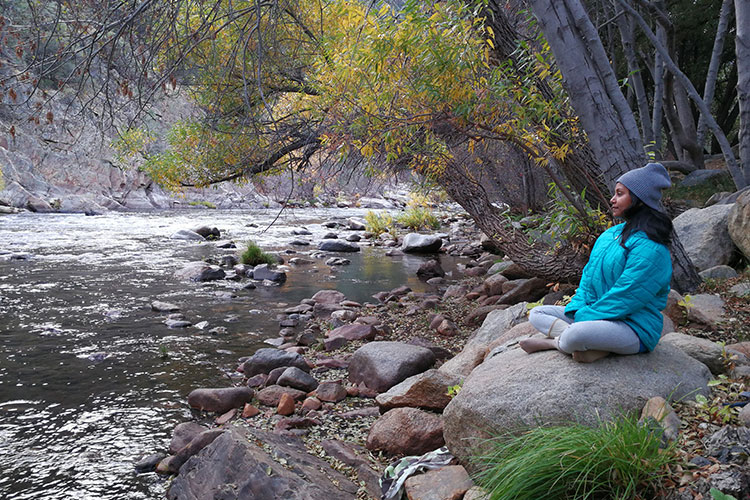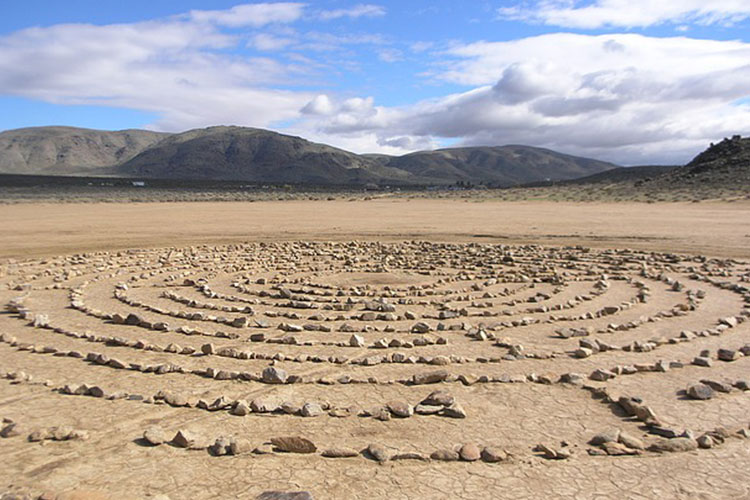Walking meditation is the best time to connect with nature, body, and mind. For beginners, selecting a path which is free from bumping into people and away from distractions is vital. As you progress, you can practice mindful walking wherever you go.
Earlier, I used to go to a nearby park in California to spend some meditative moments. As an eco-friendly person, nature helps me relaxing. One day, I was meditating in the park. A passer-by stopped to ask if I was meditating. Needless to say my concentration was broken. Another occasion, cute puppies used to come closer and sniff me when I was meditating with my closed eyes!

So at the initial level, it is better to be away from the public eye. You feel relaxed when there is nobody watching you. That is how I came across the idea of having a private walkway in home yard. Also, it would be an exciting project to create a walkway and get motivated to initiate meditation.
Contents
What is walking meditation?
Walking meditation is a method that can be used to develop mindfulness in you. Mindful walk increases awareness of your body and mind. For advanced practitioners, the insight emerged through walking meditation helps understanding the reality of life.
What is the measurement of a walkway?
When you plan a walkway, think about the number of people who uses it.
Length: Minimum 30 feet
Width: Single user – Minimum 20”
Multiple users- Minimum 40”
What are the tools and materials necessary for making a walkway?
All what you need is a grass removing tool, a weed barrier fabric, some sand, and edging material (ex: bricks, stones, logs, gabion etc.
Now, it is time to put your construction skills into action.
A simple and easy walkway tips:
Step 01- First, measure a designated area in the yard. Remove grass using a tool in the area
Step 02– Add a weed barrier material on the cleaned area. This prevents growth of weed on your walkway. Also, it is easy for maintenance afterwards
Step 03- Place edging material according to your preference.
Tip: If you are an eco-friendly person, you can use reusable edging materials, such as plastic bottles filled with sand or glass bottles
Step 04– Spread a layer of sand over the area, and flatten the surface and the project is done!
Tip: If you are concerned about exposure to weather conditions or UV rays during your walk, you can install a covered walkway.
Why should I use sand on the surface?
The touch of the sand is comfortable on the sole. Also it improves blood circulation. Other options are mulch, gravel, pallet wood, paver stones etc.
What if there is no space in the yard to make a walkway?
You can also find a quiet spot in the nature such as in a beach, near a lake, or in a park. Make sure to find an area away from the crowd and noise. Gage a length about 30 feet and start your walking meditation. At the end of the imaginary walkway, turn around mindfully and start walking back.
How to use indoor space for walking meditation?
Considering unpredictable weather conditions, it is better to think about an indoor space for walking meditation as well. Allocate any space available inside your home or at any other place. You can walk in a straight line and turn around.
Is it good to walk barefooted?
Walking bear footed on a sand path has a lot of health benefits. It is customary to take off your shoes in sacred places in some countries. According to California foot and ankle specialist Dr. Jonathan Kaplan, “walking barefoot more closely restores our natural walking pattern also known as our gait.”
Also walking barefoot has a lot of advantages such as;
1. Provides a time to ground yourself to the earth
2. Gives better control of your leg movement
3. Provides an opportunity to be away from tight shoes
4. Strengthen your leg muscles
5. Offers a time to be sensitive to the sensations of your feet
What are the potential risks of barefoot walk?
If you plan to walk barefoot in a public area, there is a risk of exposing your feet to harmful bacteria.
Also, you should be aware of sharp objects such as glass pieces, needles that can injure your feet.
However, the idea of walking meditation is to develop your mindfulness and you will notice if there is any probable danger on your walkway.
How to use a traditional walkway or labyrinth for meditation?
The traditional Buddhist walkway looks like a normal walking path and the meditator can move back and forth in a straight line.
A meditator is supposed to step mindfully from the starting point to the turnaround point. When he reaches the turnaround point, he should be aware of the fact he is turning around.
Then he can stand still for a few seconds and start mindful walk again. Likewise, the meditator practices on the path until he obtains concentration.
Comparatively, a labyrinth is a single path that leads into the centre. Once the meditator reaches the centre, he can walk back from the midpoint to the circumference.
If you are planning to visit a labyrinth on your next trip, check out World-Wide-Labyrinth Locator. The database can be searched by location or type of the labyrinth.

Can you perform walking meditation while chanting?
In Tibetan regions, a meditative walk followed by chanting is performed as a part of a pilgrimage. It is called “kora.”
According to the tradition, a pilgrim walks around a sacred site or an object clockwise while chanting. The sacred object is called ne`. A ne` can be natural sites (such as sacred mountains or lakes), man-made sites (monasteries and pagodas) or hidden lands in the Mount Himalaya.
Anyway, if you are familiar with walking meditation technique, you can perform it while chanting as well.
Hopefully, this article will encourage you to begin walking meditation on your newly built walk way and uplift mindfulness gradually.
Photo by Gina Santangelo on Unsplash
